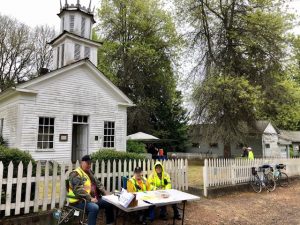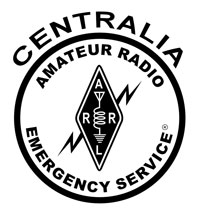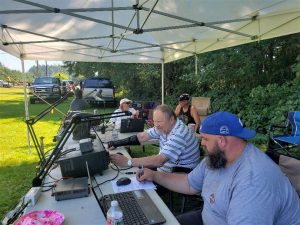
Field Day is always interesting. Last year we dealt with Covid-19 issues and concerns. This year we held Field Day during the hottest weather ever seen in the Pacific Northwest. Field Day is all about taking amateur radio into the field and making it work. It tests our ability to be flexible, to use alternate power sources and to face all kinds of problems head on. As an Amateur Radio Emergency Service (ARES) team serving our local police and fire departments, it is exactly what we are looking for in an exercise. Plus it is just plain fun!
This year, our ARES team set up four transmitter stations: 20 meters using a crank up mast and beam antenna in an open field, a 40 meter station in one of our mobile communications vans, a 15 / 80 meter station in the other mobile comms van and a 10 meter station in a members truck. While setting up the comms vans is relatively easy, it is an all hands on deck job to erect the tower and beam safely – especially in record heat.
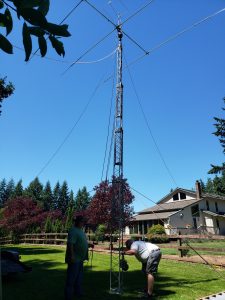
As part of our ARES mission, we added a few things to our Field Day program. Saturday morning before Field Day began, we conducted propagation tests from our FD site to a high overlook point we use for many of our exercises. We checked our normal repeaters as well as the club repeater. We checked 6 meters simplex, 6 meter repeater, 10 meter propagation and all of our simplex frequencies. All worked well. Next we tasked team member Diane W7DWD, to send a radio report from our local airport back to our FD site involving a pretend supply drop of food, water and supplies. Midway through Saturday, we had a lesson in how to assemble and erect a military NVIS antenna. Once we established its frequency we were able to make some decent contacts as well. Sunday morning we tested propagation from the main fire department amateur radios back to the field day site again through various repeated and simplex frequencies.
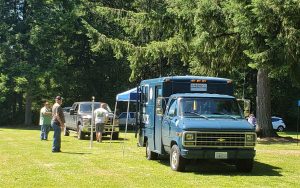
Field Day is not all work however. We enjoyed a great breakfast to get us started on Saturday along with the world’s best cinnamon rolls made by one of our team members, Evelyn, and a large potluck meal mid afternoon. Both the police chief and the fire chief came to the FD site for visits. Riverside Fire Authority Chief Kytta spoke to our group about upcoming summer fire dangers and how our ARES team could help with both wildfire windshield survey work and our new Red Flag Spotter’s program.
 Field Day will probably always be about the number of contacts for most amateur radio operators but for our ARES team it is also about preparedness and working together as a team to accomplish a mission. At the end of the day if we can claim that we worked out most of the big problems and a few of the little issues, then it has been a successful Field Day exercise. Now, if we could just figure out how to stay away from the 112 degree temperatures…..
Field Day will probably always be about the number of contacts for most amateur radio operators but for our ARES team it is also about preparedness and working together as a team to accomplish a mission. At the end of the day if we can claim that we worked out most of the big problems and a few of the little issues, then it has been a successful Field Day exercise. Now, if we could just figure out how to stay away from the 112 degree temperatures…..

 The Pacific Northwest, and in particular, the western half of Washington State is not generally known for its summertime wildfires when compared to other states like California and Oregon. Most people think of our part of Washington State as a lush, green heavily forested area and while that is true, every county has its share of lowland grass or hay fields that become tinder dry when warm summer weather arrives.
The Pacific Northwest, and in particular, the western half of Washington State is not generally known for its summertime wildfires when compared to other states like California and Oregon. Most people think of our part of Washington State as a lush, green heavily forested area and while that is true, every county has its share of lowland grass or hay fields that become tinder dry when warm summer weather arrives.
